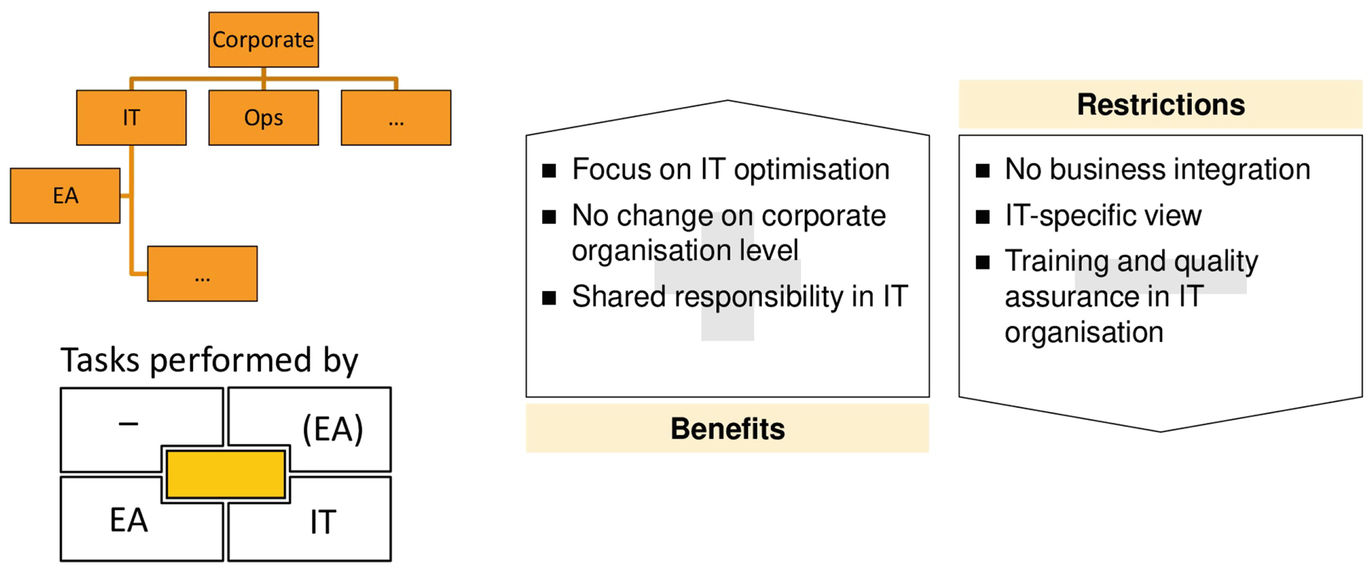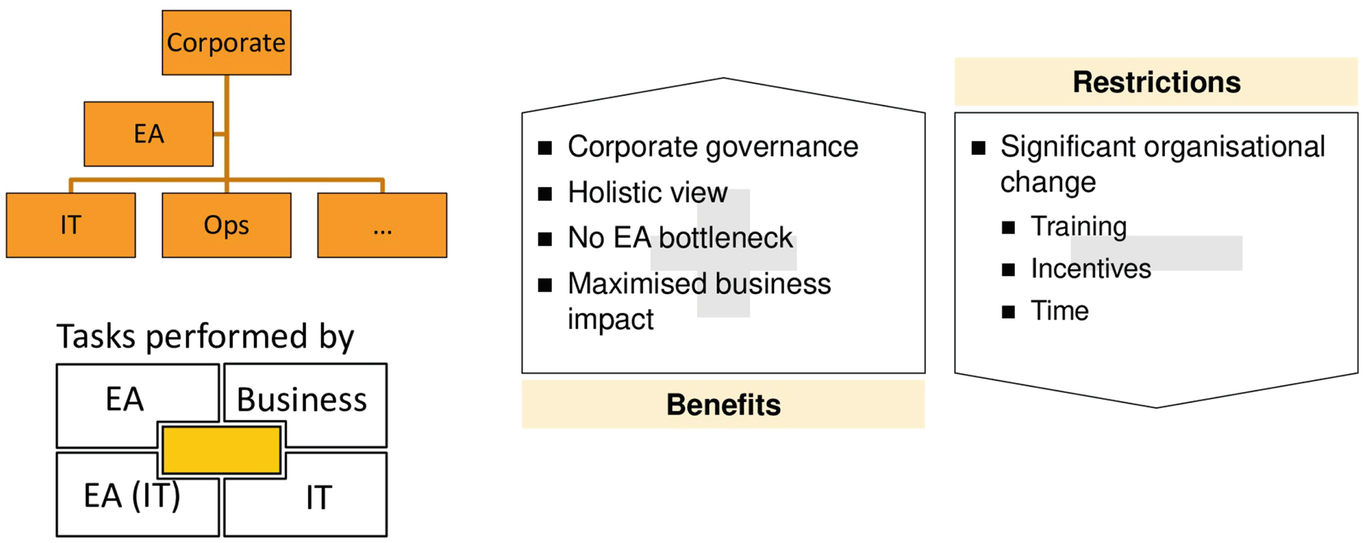Chatper 5.2 - Role and Organizational Structure of Enterprise Architects
Role and Organizational Structure of Enterprise Architects
In earlier sections, we’ve explored how Enterprise Architecture Management (EAM) facilitates change within an organization. It’s vital to recognize that EAM isn’t just about documenting structures; it’s also focused on enhancing them. The improvements identified are typically implemented as projects that either alter the application architecture or evolve the business processes. These two aspects are deeply interconnected; changes in business often necessitate alterations in applications, and vice versa. Who orchestrates these changes? This is where the enterprise architect comes into play, tasked with preparation, planning, decision-making, and supporting the implementation of changes.
This section will delve into two key elements, as illustrated in Figure below:
- Enterprise Architect Role: Identifying the skills and duties of those in the role of an enterprise architect.
- Enterprise Architecture Organization: Discussing the traditional organizational structure that supports EA within a company.

Before examining the organizational positioning of EAM, it’s essential to have a shared understanding of the enterprise architect’s role. Next, we’ll explore various options for integrating architecture management within an organization and evaluate their effectiveness.
Section 5.3 will offer a critique of EAM as it currently operates in many organizations and will look ahead to current and future methodologies that favor a more collaborative EA approach, as opposed to traditional methods. We’ll consider how organizations might adopt a service-centered approach or even a collaborative model for EAM. It’s important to clarify that historically, EAM has been seen primarily as a governance tool, and this perspective persists in many businesses. For comprehensive optimization, such as significant changes, top-down enablement through governance tools and methods is necessary. However, EA can also be effective on a smaller scale. Given the criticism of governance-focused models, new strategies are emerging that balance governance with more collaborative and service-oriented approaches.
Enterprise Architect Role Exploration

Understanding the Enterprise Architect
The Enterprise Architect, either an individual or a team, provides Enterprise Architecture Management (EAM) within an organization. This role encompasses:
- Essential skills and knowledge for EAM
- Specific tasks and activities of an enterprise architect
Enterprise Architect Defined
An Enterprise Architect is a role defined by a combination of skills, knowledge, and responsibilities within an organization. This role is vital for maintaining the integrity and utility of the company’s architecture.
Responsibilities of an Enterprise Architect
- Creation of various architectural artifacts
- Collection and verification of architecture-related information
- Quality assurance for all architectural outputs
- Support stakeholders in applying architectural artifacts
- Ensure compliance with data protection and security during information dissemination
- Update and maintain the EA repository and related maps
The Dynamic Nature of EAM
- Selection and implementation of appropriate methodologies and frameworks
- Tool selection for EA work
- Adapting processes to align with organizational needs
- Setting up and managing an EA team
- Integrating EAM with existing governance mechanisms
- Maintaining organizational flexibility while ensuring architectural quality
Essential Skills for Enterprise Architects
- Strong communication and collaboration capabilities
- Leadership and team-oriented mindset
- Ability to address corporate-level issues holistically
- Consulting-like approach to engaging with stakeholders
- Diplomacy and social intelligence
- Creation of intuitive visualizations for stakeholders
- Organizational and adaptable to business and environmental changes
- Persistence in advocating for architectural quality
Daily Tasks and Strategic Activities
- Collecting and maintaining application data
- Connecting applications with business objectives
- Providing maps of the application landscape for stakeholders
- Performing EA analysis and application portfolio management
- Facilitating IT and business changes
- Maintaining IT architecture with a long-term methodology
- Defining quality criteria for application landscape evolution
- Setting up methodologies for application portfolio management
- Implementing quality assurance in IT
Enterprise Architect’s Role in Business Processes
- Involvement in business process teams
- Maintenance of the business object model
- Communication and facilitation of business process changes
- Shared responsibility in business support modeling
Strategic Implications for the Organization
- Involvement in defining corporate vision and strategy
- Developing guidelines for business architecture
- Consulting on organizational design and KPI systems
Key Takeaways
- Enterprise architects play a multifaceted role, requiring a blend of technical, managerial, and interpersonal skills.
- The role is dynamic, with a balance between operational tasks and strategic planning.
- Effective communication, visualization, and stakeholder engagement are critical for success.
- Enterprise architects must remain adaptable yet persistent to maintain architectural integrity amidst organizational change.
Enterprise Architecture Organization Overview
Understanding the Role of Enterprise Architecture
As we’ve previously outlined, an enterprise architect’s role encompasses a range of responsibilities, skills, and typical activities. With that foundation, we can now explore the organizational structure of Enterprise Architecture (EA).
Defining Enterprise Architecture Organization (EAO)
An EAO is a dedicated unit within a company that facilitates Enterprise Architecture Management (EAM). It is composed of professionals with expertise in EA, and typically takes one of two forms:
- Enterprise architecture team: A group of enterprise architects who directly engage in EA activities.
- Competency center: A hub for spreading EAM knowledge throughout the company.
Traditionally, EA is seen as a top-down strategic support unit for management. Depending on who champions it, the EAO might fall under IT (backed by the IT head) or operate at a corporate level (driven by top executives).
Organizational Integration Options for EAM
We’ll discuss four different ways to integrate EAM within a company, each with its own advantages and challenges. Additionally, we’ll highlight the activities typically associated with different organizational units as seen in Figure below. While the distribution of tasks is not rigid, it provides a general idea of where responsibilities lie.

- As Part of the IT Organization:
- Pros:
- Close collaboration with IT teams.
- Simplified introduction of EA into the company.
- Cons:
- Limited influence on strategic decisions.
- Disconnection from business processes and corporate management.
- Potentially reduced authority and understanding of business needs.
- Activities:
- Primarily focused on application landscape and portfolio management.
- Minor involvement in strategic IT aspects.
- Pros:

- As a Staff Department Directly Supporting the CIO:
- Pros:
- Shift from operational tasks to strategic IT planning.
- Opportunity to train IT staff in EA principles.
- Shared EA responsibility within IT.
- Cons:
- Potential disconnection from business stakeholders.
- Need to train IT staff for additional responsibilities.
- Activities:
- Delegates routine information collection to IT teams.
- Focus on strategic IT aspects.
- Pros:

- As a Corporate-Level Department:
- Pros:
- Equal standing with other departments.
- Improved collaboration with business units.
- Greater focus on business optimization.
- Cons:
- Possible conflicts with other corporate divisions.
- Risk of becoming a bottleneck without proper support.
- Activities:
- Maintenance of business architecture.
- Some involvement in strategic business and IT activities.
- Pros:

- As a Corporate Staff Department Consulting the CEO:
- Pros:
- Implementation of a corporate governance approach for EA.
- High-level involvement in strategic decisions.
- Holistic influence across the organization.
- Cons:
- Significant organizational changes required.
- Broad training and enablement necessary across departments.
- Activities:
- Involvement in business strategy and IT strategy development.
- Leadership in defining EA methodology at the corporate level.
- Pros:
The Ideal Form of EAM
The ultimate form of EAM is not confined to IT or on par with other departments. Instead, it operates as a corporate staff department, advising the CEO and setting the course for all other departments. The enterprise architect’s role in this setting is to lead the creation of standards and guidelines that encompass the entire organization, maximizing the business impact of EA initiatives.
While I lack firsthand experience in such a setup, the concept of EAM is clear. It’s a holistic approach that should be woven into the fabric of the company. For EAM to truly be a corporate responsibility, it must be positioned at the corporate level, influencing every part of the organization.